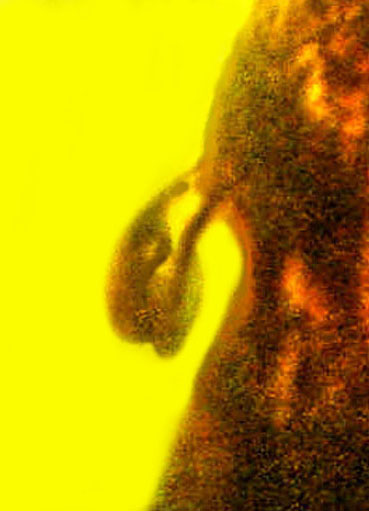Just like a Georgia O’Keefe painting, at first glance this fossil just looks like flowers, but I assure you, there’s something else going on under the surface. Not only does this 100-million-year-old fossilized amber contain the earliest evidence of sexual reproduction in plants yet discovered, the specimen was fossilized midway through the act.A few months ago, everyone had a good chuckle about those bugs that were fossilized in the middle of mating, but for whatever reason finding a plant doing the same just isn’t as funny. But, researchers from Oregon State and Germany who published their findings in the Journal of the Botanical Institute of Texas managed to be excited by their discovery of hitherto unknown, extinct plant anyway. “This is the beauty of amber fossils,” said George Poinar, Jr., the study’s lead author, “they are preserved so rapidly after entering the resin that structures such as pollen grains and tubes can be detected with a microscope.” Discovered in an amber mine in the Hukawang Valley of Myanmar, the rapidly preserved fossil gives researchers a window into life of plants in the Cretaceous period. The pollen appears sticky, which Poiner said suggests that it was carried by pollinating insects. And the fossilized pollen tubes prove that even though every generation of angiosperm plants might think they invented sex, it’s actually been around since the age of the dinosaurs.“The mechanisms for reproduction that are still with us today had already been established some 100 million years ago,” Poinar said. The fossils are the only on record that show a pollen tube growing into the flower's stigma, where it will make the seeds of the next generation of Micropetasos burmensis—or rather, it would have made the seeds of the next generation, had flowing tree sap not interrupted it.
Discovered in an amber mine in the Hukawang Valley of Myanmar, the rapidly preserved fossil gives researchers a window into life of plants in the Cretaceous period. The pollen appears sticky, which Poiner said suggests that it was carried by pollinating insects. And the fossilized pollen tubes prove that even though every generation of angiosperm plants might think they invented sex, it’s actually been around since the age of the dinosaurs.“The mechanisms for reproduction that are still with us today had already been established some 100 million years ago,” Poinar said. The fossils are the only on record that show a pollen tube growing into the flower's stigma, where it will make the seeds of the next generation of Micropetasos burmensis—or rather, it would have made the seeds of the next generation, had flowing tree sap not interrupted it.
